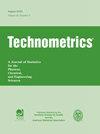基于快速排序算法的自适应加法顺序实验
IF 2.5
3区 工程技术
Q1 STATISTICS & PROBABILITY
引用次数: 0
摘要
摘要添加顺序(OofA)实验在最近的文献中受到了极大的关注。OofA实验的主要目标是确定m个分量序列中的最佳顺序。所有现有的方法都依赖于模型,并且仅限于少量的组件。由此产生的最优次序的适当性在很大程度上取决于(a)基本假设模型的正确性,以及(b)模型拟合的优度。此外,这些方法不适用于处理大的m(例如,)。考虑到这一点,本文提出了一种有效的自适应方法,建立在快速排序算法的基础上,在没有任何模型规范的情况下探索最优顺序。与现有工作相比,所提出的方法实现最优订单所需的运行规模要小得多。理论支持表明了该方法的有效性。所提出的方法能够获得大m(例如,)的最优阶数。数值实验验证了该方法的有效性。本文章由计算机程序翻译,如有差异,请以英文原文为准。
Adaptive Order-of-Addition Experiments via the Quick-Sort Algorithm
Abstract The order-of-addition (OofA) experiment has received a great deal of attention in the recent literature. The primary goal of the OofA experiment is to identify the optimal order in a sequence of m components. All the existing methods are model-dependent and are limited to small number of components. The appropriateness of the resulting optimal order heavily depends on (a) the correctness of the underlying assumed model, and (b) the goodness of model fitting. Moreover, these methods are not applicable to deal with large m (e.g., ). With this in mind, this article proposes an efficient adaptive methodology, building upon the quick-sort algorithm, to explore the optimal order without any model specification. Compared to the existing work, the run sizes of the proposed method needed to achieve the optimal order are much smaller. Theoretical supports are given to illustrate the effectiveness of the proposed method. The proposed method is able to obtain the optimal order for large m (e.g., ). Numerical experiments are used to demonstrate the effectiveness of the proposed method.
求助全文
通过发布文献求助,成功后即可免费获取论文全文。
去求助
来源期刊

Technometrics
管理科学-统计学与概率论
CiteScore
4.50
自引率
16.00%
发文量
59
审稿时长
>12 weeks
期刊介绍:
Technometrics is a Journal of Statistics for the Physical, Chemical, and Engineering Sciences, and is published Quarterly by the American Society for Quality and the American Statistical Association.Since its inception in 1959, the mission of Technometrics has been to contribute to the development and use of statistical methods in the physical, chemical, and engineering sciences.
 求助内容:
求助内容: 应助结果提醒方式:
应助结果提醒方式:


